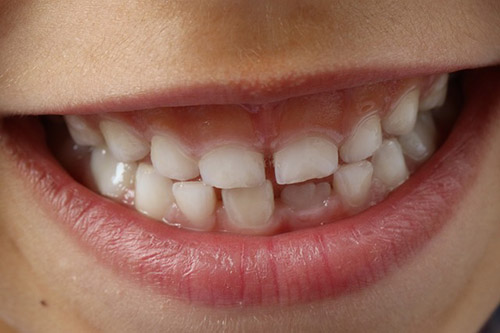
You probably already know that a cavity is a hole in a tooth. But did you know that a cavity grows over time? It starts with a small white spot. This white spot, called incipient decay, is an area where minerals have been lost from the tooth. At this point, decay can still be stopped or reversed. Enamel can repair itself with minerals from saliva, toothpaste and fluoride treatments in the dental office. But if this process continues, more minerals are lost and more enamel is destroyed, forming a cavity.
How Does a Cavity Form?
Tooth decay is caused by bacteria. The food that we eat mixes with the bacteria in our mouths and becomes plaque. As bacteria breaks down carbohydrates (sugar) in our food, it releases enamel-damaging acids.
At first, these acids decalcify the enamel surface (literally pulling Calcium out of our teeth) which creates white spots. These spots are where the enamel is weaker and more susceptible to further attacks by acid and bacteria.
In the initial stages cavity formation, the damage is reversible. If plaque is removed and tooth enamel is continuously exposed to calcium and fluoride, the enamel on the surface of the tooth can repair itself.
Unfortunately, if not removed promptly, the plaque can continue to attack tooth enamel with acid. As the process continues and bacteria moves further into the tooth, the damage becomes irreversible; too much of the tooth enamel has been destroyed for the tooth to repair itself. At this point, your dentist may recommend a filling to remove diseased and weakened tooth structure and to fill and seal the tooth to protect it from future attacks.
How Quickly Do Cavities Appear?
The time it takes for a cavity to form depends on several factors. Frequent exposure to acidic or sugary drinks and foods will cause cavities to form faster. Patients who take certain medications, have dry mouth or certain health problems are more likely to develop severe decay quickly.
Baby teeth have much thinner enamel than adult teeth. Thus, young children can get a cavity in just a few months while it could take up to a year for a cavity to form in adults.
Can a Cavity Recur?
Unfortunately, once a tooth has been fixed, it’s not immune to developing another cavity. If dietary habits, home hygiene or medications are left unchanged, the same factors that caused the first cavity to form will continue to affect the same tooth. In addition to causing a new cavity, the bacteria and acid in plaque can also break the seal between the new filling and the tooth to create a new cavity right under the filling. The effects of this can be devastating.
Can a Cavity Develop in the Time Between Dental Visits?
Surprises are fun but not when it comes to your health. In their earliest stages, cavities can show no symptoms. They can cause extreme damage and discomfort if left untreated. This is why dental exams and X-rays are so important.
Make sure that you get regular dental exams and X-rays. X-rays catch what the dentist’s eyes can’t during an oral exam. Many dentists recommend bitewing X-rays every 12 to 18 months, but guidelines from ADA and FDA are a bit looser. The different time frames are suited to a patient’s risk level for cavities: young kids who are high risk for cavities may need X-rays every six months while adults in good dental health don’t need X-rays more frequently than every 24 months.
Preventing Cavities
Stay on top of your dental health to avoid missed cavities. In between appointments, be diligent with your brushing and flossing! Avoid surprises when it comes to your oral health by maintaining regular dental visits based on your dentist’s recommendation.
